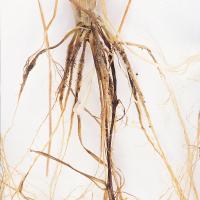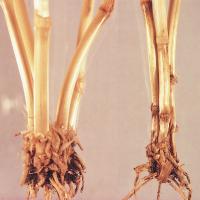Diagnosing common root rot of cereals
A fungal root disease that is not common in Western Australia (WA) but can build up to damaging levels in continuous wheat crops.
What to look for
- Affected plants tend to be scattered over a paddock, and they may be slightly stunted, have fewer tillers and produce smaller heads.
Paddock
- Browning of roots and sub-crown internode (the piece of stem emerging from the seed to the crown).
- Blackening of sub-crown internode in extreme cases.
Plant
Where did it come from?

Contaminated soil

Continuous wheat
- The fungus that causes common root rot survives on the roots of grasses and as dormant spores in the soil. It can build up to damaging levels in continuous wheat rotations.
Management strategies

Rotation
- Rotations with non-host crops such as legumes, canola or grass-free pastures lower the spore population in the soil and tend to reduce disease incidence.
- However the disease is quite persistent in the soil and a break of one year might not be enough to avoid crop damage.
See also
Where to go for expert help
Page last updated: Thursday, 16 April 2015 - 10:35am




